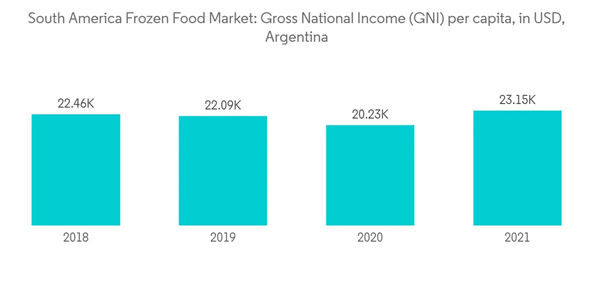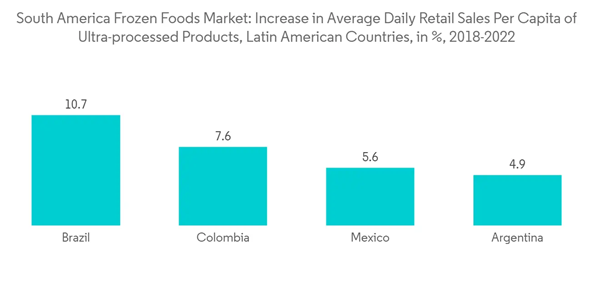The advantages of frozen food and the strong backing for technological innovation have made the items more widely available and reasonably priced for consumers in South America. Frozen food is becoming more affordable as a result of the development of new technology. Frozen food manufacturers have been appealing to consumer demand by adding variety, innovating new flavors to make frozen foods, such as poultry, seafood, desserts, etc., more palatable, adjusting portion sizes, providing organic options, and expanding health benefits, such as fiber content. There is a shift toward demand for functional foods as consumers use food to address health issues or contribute to their overall health and well-being. Additionally, the ease of use, higher shelf life, and the busy lifestyle of consumers across the region also propel the growth of the market studied.
The COVID-19 pandemic influenced market growth as people inclined more toward foods with longer shelf lives. Supply chains also shifted production away from food service and into the retail sector. Both large and small manufacturers witnessed increased sales in 2020, but changes in packaging and distribution methods benefitted major manufacturers. Furthermore, the pandemic raised consumer demand for products that are focused on health and nutrition.
South America Frozen Food Market Trends
Increase in Consumer Expenditure on Convenience Food Products
The market is primarily driven by rising expenditure on food and beverages, the introduction of products with longer shelf lives, increasing impulse purchasing, and growing demand for convenience foods that can be prepared quickly due to a shortage of available time. These factors have resulted in the need to stockpile eatables in houses that last for a longer duration without spoilage, which further increased frozen food sales. For instance, in February 2021, the American Frozen Food Institute (AFFI) reported that the sales of frozen meals, such as seafood and poultry, were 25.0% higher when compared to 2019, with an increase in sales of all types of frigid/chilled meals across South America. Due to the rise in the economy, growing working-class population, and evolved consumer lifestyle, a notable rise is observed in the expenditure for convenience food products, such as frozen foods, across South America.Due to the fast-paced lifestyles and the need for a quick meal or snack, there has been a growing demand for healthy and convenient food that can be consumed instantly. Frozen food products are considered to provide such a benefit as most of them can be cooked within less time for consumption. These factors are propelling the growth of the market studied.Moreover, manufacturers provide consumers with more foods, where much of the preparation work has been done outside the home. This development has been facilitated by technological innovations in preservation, packaging, freezing, artificial flavorings and ingredients, and by using microwaves.
Emergence of Frozen Snacks as the Fastest Growing Segment
The rapidly evolving retail landscape and the influx of multiple brands across various product categories have boosted the frozen snacks market. This is also due to the booming food service industry. The rising prominence of clean label ingredients with the label claims, such as 100% natural, non-GMO, and organic, in the country is boosting the demand for natural frozen snacks. The demand for these natural frozen food snacks is increasing due to the increasing health awareness among customers.As a result of the increasing consumer appetite and acceptance, the frozen pizza market in the region has recorded a significant growth rate. This growth rate is driven by an increase in selling points and deeper penetration by organized food service players serving pizza as a grab-and-go snack, as well as an increase in the number of available freezers in retail channels, which creates more space for frozen pizza products in the country.
South America Frozen Food Market Competitor Analysis
The South American frozen food industry is extremely competitive and has both domestic and foreign competitors. Players, including Unilever PLC, Nestle SA, General Mills, the Kraft Heinz Company, and The Kraft Heinz Company, are market leaders. These firms concentrate on utilizing the opportunities provided by expanding markets to broaden their product offering in order to meet the demands of various product areas, particularly frozen desserts. To achieve a competitive edge in the market, businesses compete on a variety of variables, such as product offerings, ingredients, quality, taste, flavor, pricing, functionality, size, packaging, and marketing initiatives.Additional benefits of purchasing the report:
- The market estimate (ME) sheet in Excel format
- 3 months of analyst support
This product will be delivered within 2 business days.
Table of Contents
Companies Mentioned (Partial List)
A selection of companies mentioned in this report includes, but is not limited to:
- McCain Foods Limited
- BRF SA
- Nestlé S.A.
- Tyson Foods Inc.
- Unilever PLC
- JBS SA
- General Mills Inc.
- The Kraft Heinz Company
- Conagra Foods Inc.
- Dr Oetker
- D'Aucy Frozen Foods










